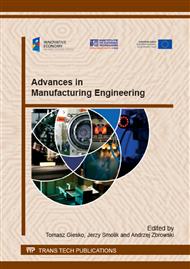p.100
p.110
p.119
p.127
p.137
p.146
p.155
p.163
p.171
The Effect of Al and Si Additions on the Resistance Properties of Magnetron-Deposited FeCrNi Coatings
Abstract:
The PVD magnetron sputtering method is one of the most efficient methods enabling the spraying of the multi-component materials and almost unlimited setting of the chemical composition of coatings. The micro-and nanocrystalline coating structure favours the selective diffusion of chromium and other alloy additions that form compact oxide layers. The paper presents the study of coatings made in the process of magnetron sputtering of AISI310S grade chromium-nickel steel. The study covered coatings of the steel's composition with additions of 2-5% Si and of 2-5% Al. The resistance of the coatings at temperatures induced by electric current flow was assessed. The coatings provided a resistance element in the electric circuit, and the measurementof their temperature was made by the voltage drop indirect method. It was found that the steel coatings had a resistance of 0.176 Ω within the entire range of testing temperature, and their failure occurred at a temperature of 350°C due to cracking and delamination from the substrate. Introducing the Si or Al addition to the coatings resulted in an increase in coating resistance and temperature stability, respectively, to 450 and 400°C. Changes of coating’s phase composition and texture were not found. The resistance of the coatings with the Al and Si additions decreased with temperature due to their oxidation.
Info:
Periodical:
Pages:
137-145
Citation:
Online since:
November 2014
Authors:
Keywords:
Price:
Сopyright:
© 2015 Trans Tech Publications Ltd. All Rights Reserved
Share:
Citation:


